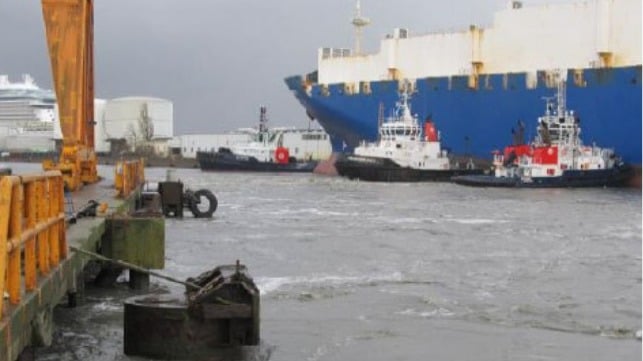Mooring Lines in Poor Condition Caused Cargo RoRo Endurance to Break Free

Worn-out mooring lines that were not replaced on time are being called the reason a US-flagged cargo RoRo broke free from its dock and out-of-control hit a pier and dry dock at the Port of Bremerhaven in Germany. Germany's Federal Bureau of Maritime Casualty Investigation (BSU) issued a report concluding that if the lines had been properly maintained, the incident might never have happened.
BSU analyzes the incident involving the RoRo cargo ship Endurance (49,000 dwt) built in 1996 and operated by ARC (American Roll-on Roll-Off Carriers). The incident occurred on March 13, 2021, when the vessel’s mooring lines broke, causing her to drift through the harbor and collide with a dry dock, among other things.
Investigators have now determined that the main cause of the line breakage was the worn mooring lines that were not replaced in good time due to an inadequate safety management system. Owing to the conditions of the mooring lines, coupled with offshore winds with gusts reaching speeds of up to 50 knots, the accident was most likely to happen despite preventive efforts by the ship’s master.
The Endurance was moored starboard side in Bremerhaven when the lines parted at about 0945. Investigators were able to establish that the master was aware of the weather forecast and conscious of the potential danger of mooring line failure. For this reason, he had taken appropriate precautionary measures against line failure by requesting tugs.
Nineteen minutes before the incident at 0924, the master had gone to the bridge because of the prevailing wind conditions at the berth. At 0930, he requested tug assistance and instructed two of his deck officers to inspect the lines. When the lines failed, he issued instructions to drop the starboard anchor, start the main engine, and raise the lowered vehicle ramp.
Before the arrival of the tugs, the 868-foot (264.6-meter) Endurance had drifted toward the Lloyd Werft dockyard. The first two tugs arrived about eight minutes after the line failures and before the main engine was running, but could not prevent the allision. It was determined that the vessel was only about 120 meters (less than 400 feet), meaning the tugs did not have enough time and space to prevent the contact.
The line failure contributed to the material damage to the ship, the berth, and the dockyard. However, nobody was injured, and no pollution was reported. The damage on the ship included a crack above the waterline in the shell plating on the port side, a hole in the bulbous bow, and a dent and paint abrasions at the stern on the starboard side.
BSU concluded in its investigation that the mooring lines were in poor condition. The vessel’s operator, ARC, had also arrived at the same conclusion in its internal investigation, determining that the condition of the lines may not have been consistent with requirements. The lines were damaged to such an extent that only two of the 14 lines met the requirements for mooring lines.
Following the BSU investigation, actions have been taken to prevent similar occurrences. They include the procurement of berth analysis software by the Port of Bremerhaven. Expected to be deployed this year, the software is designed to trigger alerts that would help the port inspect a vessel's mooring arrangement.
The report also highlights that as of January 1, 2024, new internationally binding guidelines for the inspection and maintenance of mooring equipment, including lines, came into force. In particular, the vessel operator is now required to introduce a procedure for mooring operations, as well as the inspection and maintenance of mooring equipment, including mooring lines. A maintenance procedure must be implemented on ships so that worn lines are identified in good time before they fail. Maintenance must be carried out and documented on board.
